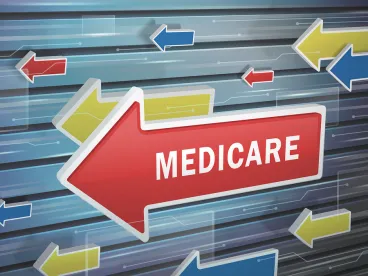Long time readers of our blog may recall that five years ago, I predicted that 2014 might be a game-changing year for the 340B Drug Discount Program. 2014 saw attempts at regulatory changes, but a successful court challenge to the 340B Orphan Drug rule and HRSA’s belief that the resulting court ruling effectively nullified its authority to issue proposed regulatory guidance in 340B halted any real changes in their tracks.
Still, last year I posited the theory that given a new CMS rule slashing Medicare Part B reimbursement for 340B drugs and a litany of pending Congressional bills proposing limits on 340B Program operations, 2018 could finally be a game-changing year for 340B.
Well, fool me twice and shame on me. None of you should be surprised that this post will not predict that 2019 will be a game-changing year for 340B.
Still, what might 2019 mean for 340B? Let’s review some recent developments and address a few predictions for the future of 340B.
Legal Challenge to OPPS Medicare Payment Reduction for 340B
In an early January 2019 blog post, I noted that the U.S. District Court for the District of Columbia had enjoined enforcement of the CMS Medicare Part B reimbursement cut for 340B drugs. The regulatory provision enjoined reduced hospital reimbursement for most 340B drugs from Average Sales Price (“ASP”) plus 6% down to ASP less 22.5% in order to approximate acquisition cost. That provision was initially adopted as part of the 2018 Outpatient Prospective Payment System (OPPS) rule. However, the Court stopped short when it came to imposing any remedy beyond injunction, recognizing that the ruling could “wreak havoc” on the complex administration of the OPPS. Instead, the Court ordered supplemental briefing on the manner, scope and implementation of any future remedy.
In the first weeks after the injunction ruling, the parties initially wrangled over the impact of the government shutdown on the imposed briefing schedule. In the weeks after the government shutdown ended, as expected, the plaintiffs moved to amend the underlying Complaint to extend the injunction to CMS’s extension of the Part B reimbursement cut for 340B drugs dispensed in non-excepted off-campus outpatient departments in the 2019 OPPS rule. In the latter part of February, the parties filed their supplemental briefs on proposed remedies:
-
Plaintiffs contend that based on the injunction, the only proper remedy is for the court to order CMS to make covered entities whole by reimbursing covered entities for any OPPS claims for 340B drugs based on ASP plus 6% instead of at ASP less 22.5%.
-
CMS contends that because of the recognized disruption to the OPPS as well as the resulting increase in costs to Medicare beneficiaries, the only appropriate remedy is to keep the injunction in place while remanding the dispute to CMS to allow the Agency to use its expertise to devise an appropriate administrative remedy. The Agency reminded the Court that the 2018 (and 2019) OPPS was premised on budget neutrality, and the plaintiffs’ proposed remedy did not appropriately account for other payment adjustments that were part of the OPPS.
As of February 28th, the Court had yet to rule on the dueling remedy proposals. However, CMS is not waiting for the Court to impose a remedy. On February 25th, CMS filed its appeal of the of the District Court decision to issue the injunction. It is possible that the District Court could keep the injunction in place but stay any further proceedings on remedies pending the outcome of the appeal.
Meanwhile, CMS’s move to appeal the ruling should not come as a surprise. One of the striking things about the District Court ruling is its basis in law. The Court did not rule that the 340B reimbursement cut violated the letter, or the spirit, of the 340B statute. Further, the Court did not rule that a reimbursement cut of almost 30% failed to approximate hospitals’ acquisition cost for 340B drugs. Instead, the ruling was based on the Court’s belief that the reimbursement cut was just too extreme to be justified under CMS’s authority to adjust Medicare reimbursement rates. The Court found that the statutory authority to “adjust” payments in Medicare did not grant the HHS Secretary the “absurdly broad power to make drastic adjustments” to Medicare reimbursements and term it equitable.
Yet, earlier this year, HHS proposed another drastic change to the drug reimbursement landscape: proposed rulemaking to eliminate protections for certain drug discounts and rebates in Medicare Part D and Medicaid Managed Care. The growing drumbeat of opposition to the proposed rules includes the argument that the Administration’s proposal is too drastic of a change to rest on HHS’s administrative authority over Medicare and Medicaid. So, the District Court’s invalidation of the 340B reimbursement cut must be challenged lest it stand as precedent for denying the Administration the discretion to take administrative action to make changes that significantly impact drug pricing and the drug reimbursement in federal healthcare programs.
Ceiling Price Validation
One area where HRSA has long had legislative authority to act was the mandate to adopt a 340B ceiling price penalty rule and to implement a ceiling price verification system for covered entities. After years of delay, the rule and verification system were finally readied in late 2016, but to the chagrin of covered entities, the Trump Administration elected to delay implementation of both the rule and the verification system.
After almost two years of continued delays, in late December 2018 the Trump Administration finally announced it was implementing the ceiling price penalty rule effective January 1, 2019. So what does that mean for the verification system?
On February 14, 2019, HRSA announced that the “secure pricing component of the 340B Office of Pharmacy Affairs Information System is now open for submission of manufacturer pricing data for the first quarter of 2019.” That means that data on ceiling prices is (hopefully) being submitted by manufacturers, but will not be available to covered entities until verified. So when will that happen?
According to the HRSA website, HRSA “expects” authorized covered entities will be able to access the verified ceiling prices for the first quarter of 2019 on April 1, 2019. Authorized covered entities must have a user account specifying appropriate roles and permissions in order to access the data. Covered entities should plan now to ensure that the appropriate staff are registered and can access the Information System once it becomes operational.
Federal Regulatory Actions/Federal Legislation
I am not really going out on a limb by predicting that there will be no further proposed federal regulation in the 340B space pending the outcome of the litigation over the OPPS rule.
Moreover, while I expect that many of the legislative proposals for 340B reform that died in the last Congress will be re-introduced, it is hard to see this Congress coming to any consensus on legislation over 340B. If there is going to be any federal legislative movement on drug prices, it may come in the area of general pricing/rebate transparency and not be focused on 340B.
State Regulatory Actions
The states are the real incubator for most drug pricing and transparency initiatives these days. Thus, anyone following 340B issues will want to stay abreast of the state initiatives that involve 340B.
First, even when the HRSA ceiling price verification system becomes operational, access will be limited to registered covered entities; states cannot access the verification system. Yet, federal law mandates that Medicaid fee-for-service reimbursement for 340B drugs be no more than actual acquisition cost, which cannot exceed the 340B ceiling price. Since it is difficult for a state to be sure that Medicaid reimbursement does not exceed ceiling price when it does not know that ceiling price, some states are taking regulatory action. Effective November 1, 2018, Colorado Medicaid requires covered entities to submit certain 340B acquisition costs to the state. Also, effective November 1, Mississippi Medicaid requires covered entities to identify 340B drugs on medical and retail Medicaid pharmacy claims and to submit drug invoices to the state for auditing. I expect more states to adopt similar reporting provisions to provide the states with transparency into 340B pricing.
Second, the federal law that required state Medicaid Programs to reimburse 340B drugs at no more than acquisition cost/ceiling price does not necessarily apply to Medicaid Managed Care plans. However, federal law also mandates that drugs supplied through Medicaid Managed Care Plans be invoiced for statutory Medicaid Drug Rebates unless they are 340B drugs subject to the duplicate discount prohibition. Some states are wary of 340B arrangements involving Medicaid Managed Care plans, PBMs, and/or manufacturers that do not share 340B savings with the state or beneficiaries. Moreover, a number of states are concerned about the added complication of use of a 340B contract pharmacy in these arrangements and very real risk of violating the duplicate discount prohibition. The state initiatives currently in place to address these issues include:
-
Most states require Medicaid Managed Care plans to identify the use of 340B drugs through use of a specified billing modifier or modifiers to reduce the risk of duplicate discounts.
-
To further limit the risk of duplicate discounts, multiple states have restricted the ability of covered entities to provide Medicaid Managed Care recipients with 340B drugs through contract pharmacies; some states have also prohibited certain types of covered entities, such as FQHCs, from supplying any Medicaid patients with 340B drugs.
-
In California, newly elected Governor Newsom issued an Executive Order directing state agencies, including Medi-Cal, to jointly negotiate prescription drug pricing through a single-purchaser system and to “take all necessary steps to transition all pharmacy services for Medi-Cal managed care to a fee-for-service benefit by January 2021.” The order is intended to ensure that the state gets the advantage of the best pricing available under bulk purchasing while maximizing California’s Medicaid Drug Rebate proceeds.
Third, I previously wrote about the 2018 National Governor’s Association Report recommendations that more states look to leverage 340B pricing by contracting with 340B covered entities to provide state-financed health services, such as in state prisons. That post noted that a recent Pew study found that Texas has reduced its drug costs in the prison population by 60% through use of a 340B contract, and that 16 states were now working with covered entities to obtain at least some of their high-cost drugs for prison populations through 340B. Although some may debate the ethics of the use of 340B in prison populations, and others may debate the impact of Medicaid Best Price reporting requirements on such arrangements, there is no debating the fact that these programs provide the states with cost savings. Expect to see more states explore such 340B arrangements.
Closing
To be fair, the states are not alone in exploring ways to leverage 340B savings. Commercial insurers are also eying the 340B Program, and considering what contracting steps can be taken outside of the federal program to rein in reimbursement rates involving 340B.
So what does 2019 hold for 340B? Well, as I said, the ceiling price verification system for covered entities will become operational in 340B, as will the penalty rule for overcharging ceiling price. Yet, recall the Supreme Court already ruled that covered entities have no private right to enforce 340B pricing. So the real question is if ceiling price violations are found, will HRSA (or OIG) actually take action in 2019 to enforce the penalty provisions? We will have to wait and see.
For now, aside from closely following the appeal of the OPPS reimbursement cut, any professionals interested in the 340B program would be wise to keep abreast of state regulatory actions addressing 340B billing practices and commercial insurer contract adjustments involving 340B. Changes will be coming, but they will most likely be on a state-by-state or contract-by-contract basis.




 />i
/>i
